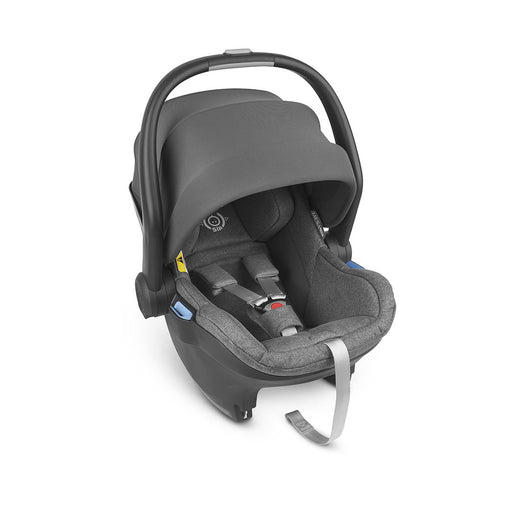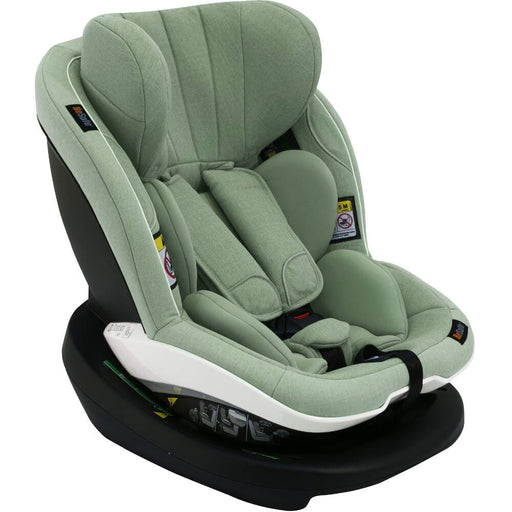Payment Plans Available
Filters
i-Size Car Seats
i-Size is a new European-wide car seat regulation (the first phase of a safety standard called R129), which aims to make car seats safer. It's designed to keep children rear-facing for longer, provide better side impact protection and make car seats easier to fit correctly.
i-Size requires children to sit rear-facing until they’re at least 15 months old. This is longer than the earlier regulations, which advise children to sit rear-facing until they weigh 9kg.
Some new i-Size car seats will enable your child to sit rear-facing up to the age of 4 years, if you wish. Why? Because studies show it’s safer. Swedish research found that rear-facing car seats can offer up to 75% more protection if your young child is involved in a car accident.
Up to the age of 15 months, your child’s neck is not yet developed enough to withstand the forces of an average head-on collision. The excessive pressure on the neck of your baby might lead to serious neck injury. Rearward-facing seats can help to spread the forces of a head-on collision over a greater area of your child’s body, leading to less pressure on your child's head and neck.
Under the older regulations, car seats only have to be tested for protection against accidents where the front or back of the car is hit. They don’t have to offer side impact protection (although many do), even though around 25% of car accidents involve a car being hit on the side.
i-Size now legally requires car seats to ensure side impact protection.
i-Size aims to reduce the confusion around car seat suitability. Currently they're categorised by weight - but we often don't know the weight of our toddler or child. However, we do know their age, and so we end up matching weight with age. However, one 9-month-old baby may have a very different weight to another.
i-Size is now being categorised by height. So the best thing to do is to measure your child's height regularly – although the likelihood is, we’ll be matching height with age.
-

BeSafe iZi Modular i-Size Base
£169.00The BeSafe iZi Modular i-Size base is compatible with both the iZi GO Modular i-Size car seat and iZi Modular car seat (sold separately). Maki...
View full details -

BeSafe iZi Modular X1 i-Size Car Seat & ISOFix Base - Fresh Black Cab - Low Stock
Original price £428.00Current price £362.00BeSafe iZi Modular Car Seat (Black Cab) & ISOfix Base included The Modular Evolution For this age the BeSafe iZi Modular, consist of one ISOfix...
View full details -

BeSafe iZi Modular X1 i-Size Car Seat - Metallic Melange
Original price £279.00Current price £238.00Please allow 7 working days for delivery (BeSafe Modular ISOfix Base Purchased Separately) The BeSafe iZi Modular car seat is an ergonomically-des...
View full details -

BeSafe iZi Modular X1 i-Size Car Seat - Fresh Black Cab - Low Stock
Original price £259.00Current price £220.00(BeSafe Modular ISOfix Base Purchased Separately) The BeSafe iZi Modular car seat is an ergonomically-designed car seat that’s suitable for childr...
View full details -

BeSafe iZi Flex Fix 2 i-Size - Fresh Black Cab
£219.00Stature height: 100 – 150 cmAge: approx. 4 – 12 yearsDirection: Forward facingInstallation: 3-point vehicle belt or ISOfix in combination with 3-po...
View full details -

BeSafe iZi Modular X1 i-Size Car Seat - Sea Green Melange
Original price £279.00Current price £238.00(BeSafe Modular ISOfix Base Purchased Separately) The BeSafe iZi Modular car seat is an ergonomically-designed car seat that’s suitable for childr...
View full details -

Joie i-Spin Car Seat i-Size - Thunder
£250.00The Joie i-Spin 360 i-Size Car Seat has a 360 pivoting protector that spins rearward, forward and everywhere in between. Now featuring i-Size secur...
View full details -

Joie i-Spin Car Seat i-Size - Shale
£250.00Please allow 5 working days for delivery or we can offer FREE fitting from store on all car seats purchased from us. The Joie i-Spin 360 i-Size Car...
View full details -

UPPAbaby Mesa i-Size Infant Car Seat - Jordan (Black/Grey Melange)
£199.00The Uppababy Mesa i-Size Infant Car Seat has been intuitively designed for comfort, safety and ease of use. The Mesa is suitable for rear facing tr...
View full details -

UPPAbaby Mesa i-Size Infant Car Seat - Jake (Black)
£199.00The Uppababy Mesa i-Size Infant Car Seat has been intuitively designed for comfort, safety and ease of use. The Mesa is suitable for rear facing tr...
View full details -

UPPAbaby Mesa i-Size Infant Car Seat - Emmett (Sage Green Melange)
£199.00The Uppababy Mesa i-Size Infant Car Seat has been intuitively designed for comfort, safety and ease of use. The Mesa is suitable for rear facing tr...
View full details -

BeSafe iZi Modular X1 i-Size Car Seat & ISOFix Base - Metallic Melange
Original price £448.00Current price £381.00BeSafe iZi Modular Car Seat (Metallic Melange) & ISOfix Base included The Modular Evolution For this age the BeSafe iZi Modular, consist of one...
View full details -

BeSafe iZi Flex Fix 2 i-Size - Metallic Melange - Delivery Mid March
Original price £239.00Current price £219.95Stature height: 100 – 150 cmAge: approx. 4 – 12 yearsDirection: Forward facingInstallation: 3-point vehicle belt or ISOfix in combination with 3-po...
View full details -

BeSafe iZi Modular X1 i-Size Car Seat & ISOFix Base - Sea Green Melange
Original price £448.00Current price £381.00BeSafe iZi Modular Car Seat (Sea Green Melange) & ISOfix Base included The Modular Evolution For this age the BeSafe iZi Modular, consist of on...
View full details -

BeSafe iZi Modular X1 i-Size Car Seat - Cloud Melange
Original price £279.00Current price £238.00(BeSafe Modular ISOfix Base Purchased Separately) The BeSafe iZi Modular car seat is an ergonomically-designed car seat that’s suitable for childr...
View full details -

BeSafe iZi Modular X1 i-Size Car Seat & ISOFix Base - Cloud Melange
Original price £448.00Current price £381.00BeSafe iZi Modular Car Seat (Cloud Melange) & ISOfix Base included The Modular Evolution For this age the BeSafe iZi Modular, consist of one IS...
View full details
















